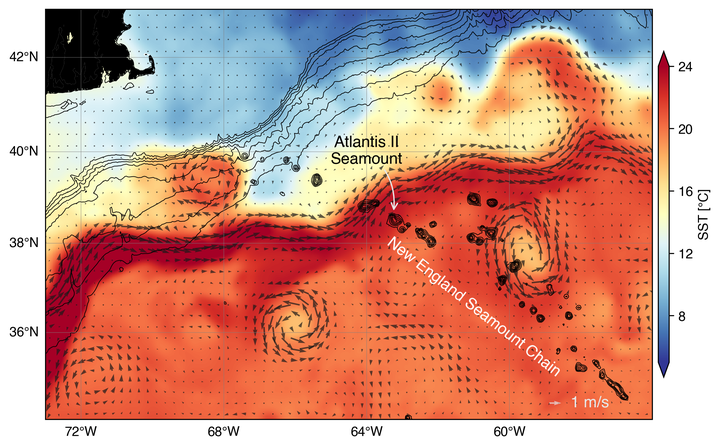New England Seamount Chain - Gulf Stream Interactions
 Satellite sea surface temperature (color) and satellite sea surface height-derived surface currents (vectors) in the New England Seamount Chain region on May 17, 2023. The Gulf Stream is visible as band of high temperature and strong currents flowing eastward.
Satellite sea surface temperature (color) and satellite sea surface height-derived surface currents (vectors) in the New England Seamount Chain region on May 17, 2023. The Gulf Stream is visible as band of high temperature and strong currents flowing eastward.The Gulf Stream emerges as a Western Boundary Current from the Gulf of Mexico and the Florida Straits. Hugging the eastern continental shelf of the North American continent, it flows northwards until it detaches from the coast at Cape Hatteras. The current soon encounters a number of submarine mountains as it heads into the open North Atlantic Ocean - the New England Seamount Chain.
Theoretical work and studies based on numerical simulations have shown the importance of the seamounts for the path the Gulf Stream takes. They also predict strong turbulent mixing in the vicinity of the seamounts as the interaction with the Gulf Stream generates internal waves and eddies in the lee. Gulf Stream - seamount interaction may thus be important for water mass transformation in the deep ocean which in turn is an important driver of the so-called Global Overturning Circulation, an important element of our climate system.
Observations of the phenomena associated with this type of flow-topography interaction are rare not only for these specific seamounts but even on a global scale. Thus, we still don’t know how close theoretical and model predictions are to reality. Within the context of the Office of Naval Research (ONR) funded Task Force Ocean (TFO) project, we are funded to deploy moorings on the flanks of Atlantis II Seamount. Using moored observations, we hope to gain insight into flow and mixing dynamics near the seamount top.